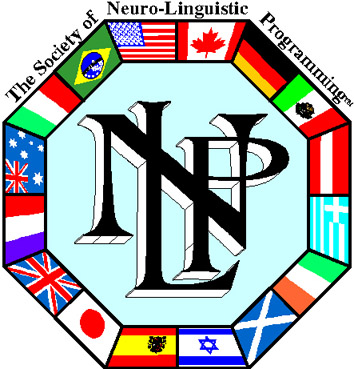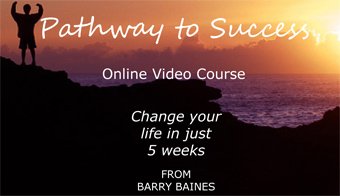NLP techniques
Changing States - NLP secret
NLP techniques for changing states doesn’t relate to travel but to the way you feel.
If you haven’t read the companion article States, it might be a good idea to do so before reading on.
You will learn there about association and dissociation and how your emotional state affects your ability to perform.

Negative feelings and negative thoughts keep peace of mind away
Anchoring the experience
Have
you noticed also how your mood or state is affected by the sound of a
particular tune or song, a smell or even another experience. This is because we anchor our experiences in different ways.
We speak of NLP anchors but in reality anchors occur naturally. NLP merely recognises them and shows us how to anchor, collapse anchors, stack them and chain them to our advantage.
If
you are an experienced driver and, as you are driving along at some speed you detect the movement of a small child at the
roadside, automatically you slow the vehicle immediately and maybe even
stop.
You don’t think to yourself, “Ah, there is a small child over there. Shall I proceed in the usual way or slow down? Shall I apply the brake? Shall I adjust the steering?”
That all sounds rather ludicrous, doesn’t it. Of course you don’t do any of those things.
You have become so used to the events that occur on the roads and the dangers around, that the moment the movement of a small child is detected in your peripheral vision it acts as an anchor which is immediately fired and the behaviour is triggered.
The whole subject of NLP anchors is so important to our everyday behaviours that if you don’t have a thorough grasp of them already, you may want to review the website page about it sooner rather than later.
NLP techniques – traumatic events
What I might call “bad anchors” are set up quite unwittingly by traumatic events.
The event itself may have been momentary but it will have been intense.
Sometimes anchors are created by the repetition of a number of less intense actions or events.
After that they influence so much of what we do and most of the time we don’t even realise it.
A fear of flying may have been triggered by knowing someone who died in an air crash or merely reading a report about an air crash in which a large number of people died.
Sadly, air crashes occasionally happen but in the meantime thousands of flights take place in perfect safety.
Far more deaths occur on the roads of the world, but you rarely hear the person who will not fly refusing to drive a motor vehicle.
NLP techniques – pattern interrupt
The
first way to change a state is to use what is called a pattern interrupt. It is
something that most good parents use with young children only they call it
distraction.
If a young child is upset because she has fallen over and bumped herself, the quickest and most peaceful way of resolving the situation is to divert her attention with a silly game, something that makes her laugh instead of cry.
Adults are not so different. You will need to gauge your interrupt according to the individual. It may be that a change of scenery is required, perhaps a walk in the park, or a joke may be good enough.
You cannot have too much laughter. If you haven’t laughed much lately, ask yourself whether you are taking yourself a little too seriously perhaps.
Music is a wonderful resource for changing states quickly. It can evoke ecstasy or pathos according to your requirements.
Experiment with the sort of music that lifts your mood when you are low, and be sure to have it to hand when you need it most.
NLP techniques – enlightened teachers
Enlightened
coaches and teachers use what are known as resource
anchors.
You will notice athletes warming up before a race performing all sorts of strange routines.
They are usually firing off their resource anchors which are equally useful if you have to sing or speak publicly, perform in any environment or have to deal with a stressful situation.
If you wish to elicit a resource state for yourself, first think of an occasion when you were actually in that state.
Let us say, for example, that you have to make a speech or presentation at work and you want to be confident.
Think of a time you were confident in any situation.
When you think of that state, see it through your own eyes: that is to say from an associated perspective, so you are actually in the state.
See what you saw. Hear what you heard. Feel what you felt. Make the colours vivid. Double the size of the picture and double it again. Turn up the volume. Intensify the feeling.
As the good feeling begins to peak, anchor that feeling. You can anchor it in any way that you like.
Kinaesthetic anchoring – that is to say, by touching a part of your body or squeezing a thumb and finger together – is the most obvious way.
But you can also anchor visually with a gesture or make an auditory anchor with the tone of voice you use.
NLP techniques – breaking the state
Once you have set the anchor, break the state by checking the time or distracting yourself for a moment. Then test the anchor by firing it. If it lifts you appropriately, that is fine. If it seems a little weak, reset it and try again.
Remember also that unless you use the anchor it will fade over time. Then remember to use it when you need it.
NLP techniques – chaining anchors

You may find it too much of a jump to move straight from a sad state to a happy one in a single leap.
That is where chaining anchors is useful. Instead of a single jump use little steps.
Try instead going from sad to neutral, then from neutral to calm and then from calm to cheerful.
Anchor each state in a different place and fire them in order to bring you to the state you desire.
Notice what makes you happy. When you experience those happy moments, anchor them.
If your mood dips or you face a challenge, fire off an appropriate anchor and get back on an even keel.
Gain FREE access to my self-confidence video
To gain free access to my self-confidence video enter your email address and first name in the box below. This will also keep you up-to-date with my free newsletter Inspirations.
As a bonus for subscribing you'll receive the first three chapters of my book Towards Success, where you can learn more about NLP techniques, from Anchors to Modelling, and my 50 favourite inspirational quotations.
Return from NLP techniques - Changing States to
The Secret of Mindpower & NLP Home
Return to Site Search & Contents Page

Change your life in just 5 weeks
Discover the pathway to success with my online video course. Learn more

Download NEW ebook Your Genius Within and find out how to uncover your own inner genius

NLP Articles
- Anchors
- Anchors explained
- Anger Management tips
- Anxiety Panic Attacks
- Beating disappointment
- Beating drug addiction
- Best self-help book
- Big events
- Body control module
- Body language attraction
- Body language flirting
- Body language in communication
- Body language interpretation
- Body language of a liar
- Body language signs
- Boost self-confidence
- Building Rapport
- Changing bad habits
- Changing beliefs
- Changing States
- Children
- Christmas (Holidays)
- Christmas & New Year greetings
- Chronic pain management
- Conquering Fear
- Crohn's Disease
- Cure for a Phobia
- Deal with your fear
- Deletion
- Determining your destiny
- Developing your senses
- Disaster to Triumph
- Distortion
- Drawing the line
- Embedded Commands
- Enthusiasm
- Exams
- Expecting the Best
- Expert Relationship Advice
- Eye accessing cues
- Fear of driving
- Fear of elevators
- Fear of flying
- Fear of the dentist
- Fear of vomiting
- Fear, Mental Blocks & Hesitation
- Fear, Uncertainty and Doubt
- Fight or flight response
- Finding Solutions
- Forever Worried?
- Friendly persuasion
- Generalisation
- Get the life you want
- Getting lucky
- Getting over your past
- Goal Setting Tips
- Goal Setting Tools
- Goal Setting Tools, More
- Great self-help books
- Grief
- Happy retirement
- Healthy Mind
- High blood pressure
- How long will I live?
- How to be lucky
- How to read body language
- Hypnosis & NLP
- Hypochondria
- Imagining perfect performance
- Improving speed reading
- Instant Mood Lift
- Interviews
- Knowing yourself
- Learn NLP
- Life Values
- Maintaining weight loss
- Make you thin
- Making it happen
- Managing change
- Meddling Mom
- Meeting People
- Mental rehearsal techniques
- Meta Model
- Metaphor
- Modelling
- Modelling Genius
- More NLP techniques for weight loss
- NLP Books
- NLP Courses
- NLP Practitioner Course
- NLP Master Practitioner Course
- NLP Secret
- NLP jargon buster
- NLP Modelling helped me
- OCD symptoms
- OCD treatment
- Overcoming low self-esteem
- Overcoming stage fright
- Pacing & Leading
- Persuasion
- Presuppositions
- Presuppositions (2)
- Problem solving
- Public Speaking
- Reaching agreement
- Reframing
- Self-confidence
- Self limiting beliefs
- Self-image
- Sportsmen Guide
- Stage fright tips
- Stammering
- States
- Stop binge eating
- Stop Smoking
- Subliminal Persuasion
- Success Principles
- Techniques for persuasion
- Techniques for weight loss
- The meaning of NLP
- Time & NLP
- Towards
- Towards & Away
- Ulcerative colitis
- Weight Loss
- Weight loss techniques
Articles on HYPNOSIS:
- Big events
- Conversational Hypnosis
- Covert hypnosis
- Deepening self-hypnosis
- Depression Hypnosis
- Handshake interrupt
- How to do self-hypnosis
- How to hypnotise your audience
- Hypnosis and Weight Loss
- Hypnosis NLP
- Hypnosis: Right or Wrong
- Hypnosis Stories
- Hypnotic language
- Hypnotism Stories
- Hypnosis story for you
- Hypnosis to quit smoking
- Instant self-hypnosis (age regression)
- Practical self-hypnosis
- Self-Hypnosis
- The Milton Model
Articles about THE SECRET of:
- Abundance Mentality
- Achieving more
- Beating Domestic Violence
- Being bothered
- Being Happy
- Best Self-help Book
- Conquering road rage
- Coping with criticism
- Dealing with pride
- Defeating stress
- Discover the secret of wealth
- Genius
- Getting off to sleep
- Getting over a break up
- Getting over your temper tantrum
- Health
- How to deal with grief
- Imagination
- Influence
- Love
- Making Money
- Managing others
- Memorising a Deck of Cards
- Memory
- My Success
- Organising Memory
- Overcoming tiredness
- Overcoming worry
- Perpetual energy
- Remembering
- Secret Law of Attraction books
- Sleeping well
- Speed Reading
- Super Memory
- Surviving a recession
- Surviving negativity
- The Secret Law of Attraction
- Towards
- Teachers of the Secret
- Waiting for God
- Wealth Building
- Weight Loss
Articles on GENIUS and MIND POWERS:
- Activating genius
- Become a genius
- How long will I live?
- Mind Powers
- Misty Reflections
- Modelling Genius
- The Secret of Genius
Articles about RELATIONSHIPS:
- Beating domestic violence
- Body language flirting
- Expert relationship advice
- Healthy family relationships
- Hurt feelings
- Love
- Relationship problem advice
- Signs of true love
- The secret of getting over a break up
Articles on WEIGHT LOSS:
- Best Weight Loss Plan
- Body control module
- Easy weight loss
- Hypnosis and Weight Loss
- Maintaining weight loss
- More NLP techniques for weight loss
- NLP techniques for weight loss
- NLP techniques to make you Thin
- NLP weight loss techniques
- Stop binge eating
- The Secret of weight loss
- Weight control help
- Weight loss tips
- Why have I lost weight?
Articles on WEALTH:
Articles about MEMORY:
Articles about COACHING:
- Barriers to effective communication
- Communication
- Executive Business Coaching
- Feedback
- Free interview tips
- Free Life Coaching
- Goal Setting Tips
- Goal Setting Tools
- Goal Setting Tools, More
- Life & Executive Coaching
- Personal Development Plan
- Problem solving
- Success Principles
- The Secret of my Success
- Time Management
Articles on SECRET and INSPIRATIONAL TEACHERS:








New! Comments
Have your say about what you just read! Leave me a comment in the box below.